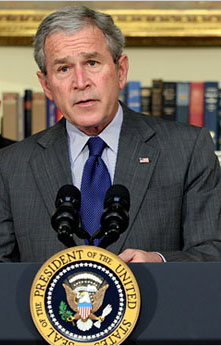Credit crunch: an end to global generosity?
by William Dowell
[The Essential Edge
Geneva
, September 25, 2008]

What impact will the US financial crisis have on organizations and agencies responsible for promoting development? For most international aid organizations it is obvious that the future looks increasingly rocky. “Am I worried?” says Marshall Burke, senior vice president for resource development at CARE-USA. “You bet! Anyone in the world of philanthropy who is not concerned is asleep at the wheel.”
Experts generally agree that Wall Street’s woes are likely to lead to the most substantial financial restructuring since the Great Depression of 1929.
The ripple effects will be felt everywhere, but especially among the world’s poorest populations. ”It will have a huge impact on poverty in developing countries,” says Robert Glasser, secretary general of CARE International. Glasser points out that the Asian financial crisis in the 1990s nearly doubled the poverty level in Indonesia.
The threat to the developing world is not only from reduced aid funding in the future. Many programs already underway have had to be slimmed down because budgets calculated in US dollars have experienced collateral damage as the dollar’s value goes into a tailspin on international currency markets.
Even more serious is the likelihood that foreign investment in developing countries—probably the greatest factor in growth at the moment—is likely to be severely affected by the liquidity crisis. If international credit dries up, or becomes much more expensive, investors are likely to think twice before gambling on a new plant in Senegal.
Reduced demand for goods is also likely to have a direct impact on export earnings in developing countries, especially in China, which now does much of the world’s manufacturing.
The pressures competing with aid to developing countries are also being increased by a perfect storm of events including the shift of farmland to biofuels and the increasingly frequent destruction of third world food supplies by natural disasters resulting from climate change. The World Bank reports that in many developing areas, food prices have increased by 83% over the last three years.
The picture is not all dark. Food exporters such as Myanmar, which normally produces about a seventh of the world’s rice crop, may actually increase their export earnings due to rising food prices.
The danger, though, is that the sudden surge in agricultural earnings is likely to be unevenly distributed, thus adding even more to the current levels of social inequality. Living on the Edge of Emergency, a report published by CARE last week, recounted the case of a poor woman in Ghana who earned a subsistence living by collecting and selling shea nuts. The trees producing the nuts were cut down to make way for a plantation dedicated to biofuels. “Where do I go now,” asked the woman. “What do I do now?”
As one pillar after another of American free market capitalism hits the dust, international aid organizations may need to start thinking about their own survival. The larger NGOs such as CARE International, which operates in nearly 70 countries, have multiple currency holdings, so while their dollar investments are losing value, other currencies may be gaining. International aid organizations based in Canada, for instance, have gained financial clout as the Canadian dollar has increased in value relative to the US dollar. Philanthropic donations from Europe are becoming much more important as the euro’s buying power surges. The effect is to shift more of the capacity for influencing development, and the responsibility for following through, to Europe.The American contribution will almost certainly be affected by the shifting landscape. AIG, the giant insurance company that recently went under, previously contributed US$5 million to philanthropies. Not anymore. US foundations are required by law to give 5% of their investment earnings to charities, but as investment portfolios decrease in size, the contributions will follow suit. The loss is likely not to be that significant, however, since foundations only make up around 12% of US charitable giving.
The current setbacks come after a record year in 2007, in which Americans gave $306 billion to charities. Of that amount, slightly more than $10 billion went to organizations involving international development. About half the total amount went to religious organizations. Corporate donations add up to around 5% of the total. An increasing proportion of this is combined with marketing ventures, such as credit card offers in which a small percentage of total expenditures is redirected towards philanthropies. The vast mass of giving –at least in the US-- comes from private individuals. The good news is that the total amount of American giving has remained fairly stable through numerous recessions in the past. It is usually around 2%. The exception was the 9/11 attacks against New York’s World Trade Center. US charitable contributions briefly stopped as the country went into a kind of collective shock. The slowdown only lasted for a brief spell though. Within a year, it had resumed its normal level.
Most funding experts now expect a drop-off in US domestic funding for education and cultural projects, but based on past experience, they see a continuing commitment to humanitarian issues. Americans will very likely continue to give as much as they are giving now. The caveat is that the dollars they give are likely to be worth considerably less. That will shift even more of the burden for developing the third world to Europe, Japan and the emerging economies. With development aid comes a global philosophy. Until now, the US has been a major cultural influence in many developing countries, simply because it had the resources to dispense aid. China is now engaged in an impressive surge of investment in Africa. It remains to be seen whether Europe will take up the challenge.